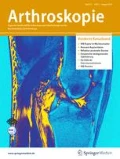Zusammenfassung
Die Rehabilitation nach operativem Ersatz des vorderen Kreuzbandes trägt wesentlich zum Erfolg der Operation bei, da negative Folgen wie die Entwicklung einer Arthrofibrose verhindert werden können und die Zeit bis zur Wiederherstellung der Muskelkraft und der Rückkehr zur sportlichen Belastbarkeit verkürzt wird. Die Rehabilitation kann in 4 Phasen unterteilt werden, bei denen unterschiedliche Ziele im Vordergrund stehen:
-
Phase 1, präoperativ: Abbau der Schwellung und Wiederherstellen der Beweglichkeit,
-
Phase 2, 1.–2. Woche postoperativ: Wundheilung, freie Streckung, Abbau der Schwellung,
-
Phase 3, 3.–6. Woche postoperativ: zunehmende Beugung, normales Gangbild,
-
Phase 4, ab der 7. Woche: Wiedererlangung der Kraft, Rückkehr zu sportlicher Belastung.
Die Inhalte der Rehabilitation umfassen physikalische Maßnahmen, krankengymnastische und manualtherapeutische Techniken und trainingstherapeutische Methoden. Der Einsatz zusätzlicher Maßnahmen wie Funktionsorthesen, Muskelstimulationsgeräten und Bewegungsschienen erscheint von fraglichem Erfolg. Grundsätzlich müssen Rehabilitationsmaßnahmen auf die individuelle Situation des Patienten abgestimmt werden und erfolgen nach einem Stufenplan. Die Rehabilitation muss in Abstimmung mit dem Operateur erfolgen und sollte von ärztlicher Seite bis zum Abschluss kontrolliert werden. Mit den aktuellen Methoden ist eine Wiederaufnahme kniebelastender Sportarten nach Kreuzbandersatz nach etwa 6–9 Monaten möglich.
Abstract
Rehabilitation after anterior cruciate ligament (ACL) reconstruction largely contributes to the success of this procedure since negative events such as the development of arthrofibrosis can be prevented and the time to regain muscle strength and the return to sports can be diminished.
Rehabilitation can be divided into four distinct phases that are characterized by different goals of treatment:
-
phase 1, preoperative: reduction of swelling and regaining range of motion,
-
phase 2, 2 weeks postoperative: wound healing, full extension, reduction of swelling,
-
phase 3, 3–6 weeks postoperative: increasing flexion, normal gait pattern,
-
phase 4, after 7 weeks: regaining muscle strength, return to sports.
Rehabilitation measures include various forms of physical therapy and systematic exercise training. Additional activities such as the use of functional bracing, electrical muscle stimulation, and motorized range-of-motion machines remain controversial. In all cases rehabilitation measures have to be adapted to the individual situation of the patient and should follow the goals of treatment according to the phases described above. Specific restrictions imposed by the surgeon must always be considered and regular visits to a physician are recommended throughout the rehabilitation phase. By adhering to current rehabilitation programs, full recovery and return to sports after ACL reconstruction can be achieved in most cases within 6–9 months after surgery.





Literatur
Beynnon BD, Fleming BC, Johnson RJ, Nichols CE, Renstrom PA, Pope MH (1995) Anterior cruciate ligament strain behavior during rehabilitation exercises in vivo. Am J Sports Med 23:24–34
Bynum EB, Barrack RL, Alexander AH (1995) Open versus closed chain kinetic exercises after anterior cruciate ligament reconstruction. A prospective randomized study. Am J Sports Med 23:401–406
Cascio BM, Culp L, Cosgarea AJ (2004) Return to play after anterior cruciate ligament reconstruction. Clin Sports Med 23:395–408
Cohn BT, Draeger RL, Jackson DW (1989) The effects of cold therapy in the postoperative management of pain in patients undergoing anterior cruciate ligament reconstruction. Am J Sports Med 17:344–349
DeMaio M, Noyes FR, Mangine RE (1992) Principles for aggressive rehabilitation after reconstruction of the anterior cruciate ligament. Orthopedics 15:385–392
Feller JA, Cooper R, Webster KE (2002) Current Australian trends in rehabilitation following anterior cruciate ligament reconstruction. Knee 9:121–126
Frank CB, Jackson DW (1997) The science of anterior cruciate ligament reconstruction. J Bone Joint Surg 79-A:1556
Hendriksson M, Ledin T, Good L (2001) Postural control after anterior cruciate ligament reconstruction and functional rehabilitation. Am J Sports Med 29:359–363
Höher J, Bach T, Klein J, Tiling T (1996) Stellenwert der Rearthroskopie nach vorderer Kreuzbandoperation. Arthroskopie 9:174–179
Höher J, Tingart M, Tiling T (1999) Prophylaxe der Arthrofibrose. Arthroskopie 12:123
Howell SM, Taylor MA (1996) Brace-free rehabilitation, with early return to activity, for knees reconstructed with a double-looped semitendinosus and gracilis graft. J Bone Joint Surg [Am] 78:814–825
Irrgang JJ (1993) Modern trends in anterior cruciate ligament rehabilitation: nonoperative and postoperative management. Clin Sports Med 12:797–813
Kvist J (2004) Rehabilitation following anterior cruciate ligament injury: current recommendations for sports participation. Sports Med 34:269–280
Muneta T, Sekiya I, Ogiuchi T, Yagishita K, Yamamoto H, Shinomiya K (1998) Effects of aggressive early rehabilitation on the outcome of anterior cruciate ligament reconstruction with multi-strand semitendinosus tendon. Int Orthop 22:352–356
Risberg MA, Holm I, Steen H, Eriksson J, Ekeland A (1999) The effect of knee bracing after anterior cruciate ligament reconstruction. Am J Sports Med 27:76–83
Rose T, Engel T, Bernhard J, Hepp P, Josten C, Lill H (2003) Differences in the rehabilitation period following two methods of anterior cruciate ligament replacement: semitendinosus/gracilis tendon vs. ligamentum patellae. Knee Surg Sports Traumatol Arthrosc
Rougraff B, Shelbourne KD, Gerth PK, Warner J (1993) Arthroscopic and histologic analysis of human patellar tendon autografts used for anterior cruciate ligament reconstruction. Am J Sports Med 21:277–284
Rubinstein RA, Shelbourne KD, VanMeter CD, Mc Caroll JR, Rettig AC, Gloyeske RL (1995) Effect on knee stability if full hyperextension is restored immediately after autogenous bone-patellar tendon-bone anterior cruciate ligament reconstruction. Am J Sports Med 23:365–368
Schulte-Frei B, Horst H, Horst F (2003) Trainingstherapie bei Verletzungen und Erkrankungen des Bewegungsapparates. In: ❚ (Hrsg) Training in der Therapie—Grundlagen und Praxis. Urban & Fischer, München Jena, S 387–508
Shelbourne KD, Passler HH (1993) Rehabilitation nach vorderem Kreuzbandersatz. Orthopäde 22:421–435
Snyder-Mackler L, Delitto A, Bailey SL, Stralka SW (1995) Strength of the quadriceps femoris muscle and functional recovery after reconstruction of the anterior cruciate ligament. A prospective randomized clinical trial of electrical stimulation. J Bone Joint Surg 77-A:1166–1173
Tegner Y, Lysholm J, Lysholm M, Gillquist J (1986) A performance test to monitor rehabilitation and evaluate anterior cruciate ligament injuries. Am J Sports Med 14:156–159
Danksagung:
Der Autor dankt Hrn. Uwe Schmidt, Physiosport Köln für technische Unterstützung bei der Erstellung der Abbildungen.
Interessenkonflikt:
Keine Angaben
Author information
Authors and Affiliations
Corresponding author
Rights and permissions
About this article
Cite this article
Höher, J. Rehabilitation nach operativem Ersatz des vorderen Kreuzbandes. Arthroskopie 18, 41–47 (2005). https://doi.org/10.1007/s00142-004-0286-7
Issue Date:
DOI: https://doi.org/10.1007/s00142-004-0286-7

